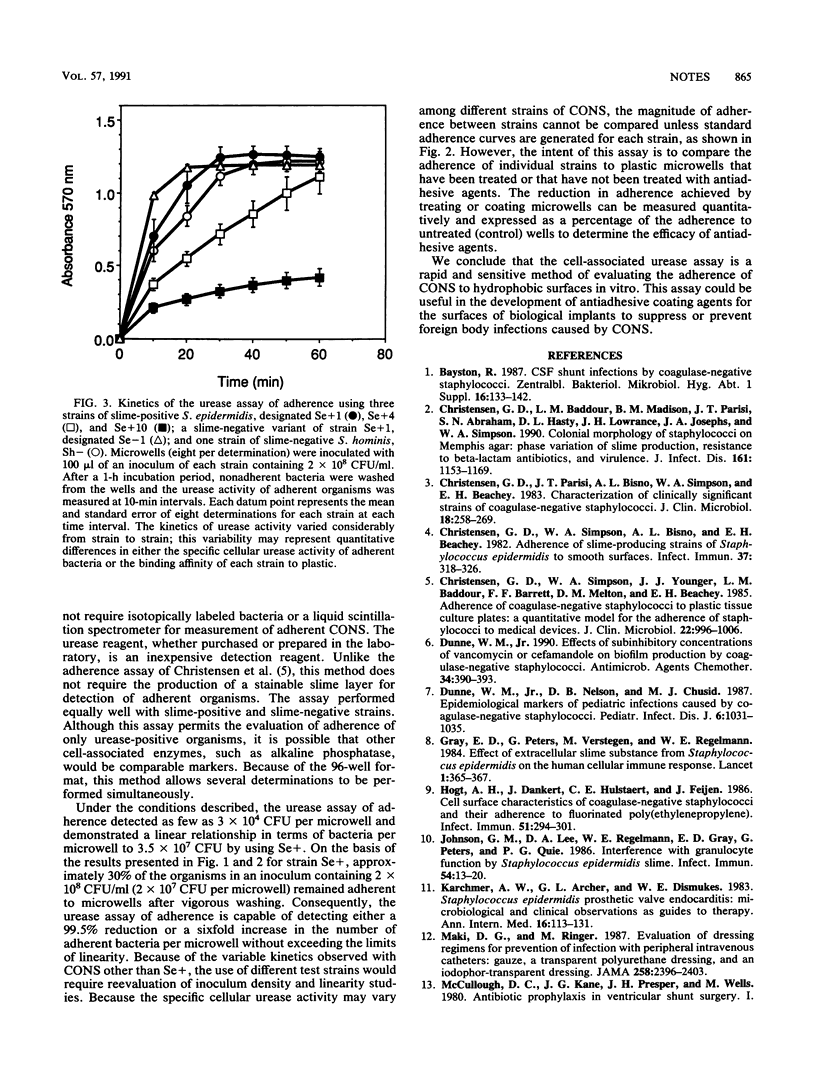Abstract
A rapid and sensitive in vitro assay was developed to quantitatively assess the adherence of Staphylococcus epidermidis to a hydrophobic plastic surface. The assay is based upon the detection of cell-associated urease activity as a marker of bacteria remaining adherent to the polystyrene microwells of flat-bottomed, 96-well tissue culture plates. Using ATCC 35984, a slime-producing strain of S. epidermidis, the assay could detect as few as 3 x 10(3) bacteria and was linear to 3.5 x 10(7) bacteria. The adherence of both slime-positive and slime-negative coagulase-negative staphylococci could be evaluated by using this method. This assay could be used to examine factors which influence the adherence of individual S. epidermidis strains to hydrophobic surfaces and to develop agents or coating materials which suppress the adherence of coagulase-negative staphylococci to biomedical implants.
Full text
PDF



Selected References
These references are in PubMed. This may not be the complete list of references from this article.
- Christensen G. D., Baddour L. M., Madison B. M., Parisi J. T., Abraham S. N., Hasty D. L., Lowrance J. H., Josephs J. A., Simpson W. A. Colonial morphology of staphylococci on Memphis agar: phase variation of slime production, resistance to beta-lactam antibiotics, and virulence. J Infect Dis. 1990 Jun;161(6):1153–1169. doi: 10.1093/infdis/161.6.1153. [DOI] [PubMed] [Google Scholar]
- Christensen G. D., Parisi J. T., Bisno A. L., Simpson W. A., Beachey E. H. Characterization of clinically significant strains of coagulase-negative staphylococci. J Clin Microbiol. 1983 Aug;18(2):258–269. doi: 10.1128/jcm.18.2.258-269.1983. [DOI] [PMC free article] [PubMed] [Google Scholar]
- Christensen G. D., Simpson W. A., Bisno A. L., Beachey E. H. Adherence of slime-producing strains of Staphylococcus epidermidis to smooth surfaces. Infect Immun. 1982 Jul;37(1):318–326. doi: 10.1128/iai.37.1.318-326.1982. [DOI] [PMC free article] [PubMed] [Google Scholar]
- Christensen G. D., Simpson W. A., Younger J. J., Baddour L. M., Barrett F. F., Melton D. M., Beachey E. H. Adherence of coagulase-negative staphylococci to plastic tissue culture plates: a quantitative model for the adherence of staphylococci to medical devices. J Clin Microbiol. 1985 Dec;22(6):996–1006. doi: 10.1128/jcm.22.6.996-1006.1985. [DOI] [PMC free article] [PubMed] [Google Scholar]
- Dunne W. M., Jr Effects of subinhibitory concentrations of vancomycin or cefamandole on biofilm production by coagulase-negative staphylococci. Antimicrob Agents Chemother. 1990 Mar;34(3):390–393. doi: 10.1128/aac.34.3.390. [DOI] [PMC free article] [PubMed] [Google Scholar]
- Dunne W. M., Jr, Nelson D. B., Chusid M. J. Epidemiologic markers of pediatric infections caused by coagulase-negative staphylococci. Pediatr Infect Dis J. 1987 Nov;6(11):1031–1035. [PubMed] [Google Scholar]
- Gray E. D., Peters G., Verstegen M., Regelmann W. E. Effect of extracellular slime substance from Staphylococcus epidermidis on the human cellular immune response. Lancet. 1984 Feb 18;1(8373):365–367. doi: 10.1016/s0140-6736(84)90413-6. [DOI] [PubMed] [Google Scholar]
- Hogt A. H., Dankert J., Hulstaert C. E., Feijen J. Cell surface characteristics of coagulase-negative staphylococci and their adherence to fluorinated poly(ethylenepropylene). Infect Immun. 1986 Jan;51(1):294–301. doi: 10.1128/iai.51.1.294-301.1986. [DOI] [PMC free article] [PubMed] [Google Scholar]
- Johnson G. M., Lee D. A., Regelmann W. E., Gray E. D., Peters G., Quie P. G. Interference with granulocyte function by Staphylococcus epidermidis slime. Infect Immun. 1986 Oct;54(1):13–20. doi: 10.1128/iai.54.1.13-20.1986. [DOI] [PMC free article] [PubMed] [Google Scholar]
- Maki D. G., Ringer M. Evaluation of dressing regimens for prevention of infection with peripheral intravenous catheters. Gauze, a transparent polyurethane dressing, and an iodophor-transparent dressing. JAMA. 1987 Nov 6;258(17):2396–2403. [PubMed] [Google Scholar]
- Peters G., Locci R., Pulverer G. Microbial colonization of prosthetic devices. II. Scanning electron microscopy of naturally infected intravenous catheters. Zentralbl Bakteriol Mikrobiol Hyg B. 1981;173(5):293–299. [PubMed] [Google Scholar]
- Sanford B. A., Thomas V. L., Ramsay M. A. Binding of staphylococci to mucus in vivo and in vitro. Infect Immun. 1989 Dec;57(12):3735–3742. doi: 10.1128/iai.57.12.3735-3742.1989. [DOI] [PMC free article] [PubMed] [Google Scholar]
- Sattler F. R., Foderaro J. B., Aber R. C. Staphylococcus epidermidis bacteremia associated with vascular catheters: an important cause of febrile morbidity in hospitalized patients. Infect Control. 1984 Jun;5(6):279–283. doi: 10.1017/s0195941700060331. [DOI] [PubMed] [Google Scholar]
- Segura M., Alía C., Oms L., Sancho J. J., Torres-Rodríguez J. M., Sitges-Serra A. In vitro bacteriological study of a new hub model for intravascular catheters and infusion equipment. J Clin Microbiol. 1989 Dec;27(12):2656–2659. doi: 10.1128/jcm.27.12.2656-2659.1989. [DOI] [PMC free article] [PubMed] [Google Scholar]
- Stotter A. T., Ward H., Waterfield A. H., Hilton J., Sim A. J. Junctional care: the key to prevention of catheter sepsis in intravenous feeding. JPEN J Parenter Enteral Nutr. 1987 Mar-Apr;11(2):159–162. doi: 10.1177/0148607187011002159. [DOI] [PubMed] [Google Scholar]
- Tojo M., Yamashita N., Goldmann D. A., Pier G. B. Isolation and characterization of a capsular polysaccharide adhesin from Staphylococcus epidermidis. J Infect Dis. 1988 Apr;157(4):713–722. doi: 10.1093/infdis/157.4.713. [DOI] [PubMed] [Google Scholar]
- Trooskin S. Z., Donetz A. P., Harvey R. A., Greco R. S. Prevention of catheter sepsis by antibiotic bonding. Surgery. 1985 May;97(5):547–551. [PubMed] [Google Scholar]
- West T. E., Walshe J. J., Krol C. P., Amsterdam D. Staphylococcal peritonitis in patients on continuous peritoneal dialysis. J Clin Microbiol. 1986 May;23(5):809–812. doi: 10.1128/jcm.23.5.809-812.1986. [DOI] [PMC free article] [PubMed] [Google Scholar]
- Younger J. J., Christensen G. D., Bartley D. L., Simmons J. C., Barrett F. F. Coagulase-negative staphylococci isolated from cerebrospinal fluid shunts: importance of slime production, species identification, and shunt removal to clinical outcome. J Infect Dis. 1987 Oct;156(4):548–554. doi: 10.1093/infdis/156.4.548. [DOI] [PubMed] [Google Scholar]


